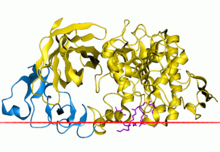
Back إنزيمات البنكرياس (دواء) Arabic Mədəaltı vəzi fermentləri Azerbaijani Enzimas pancreáticas (medicamento) Spanish Enzymes pancréatiques (médicament) French Pankreatin Croatian ଅଗ୍ନାଶୟ ଏଞ୍ଜାଇମ (ଡାକ୍ତରୀ ବ୍ୟବହାର) OR Enzimas pancreáticas (medicação) Portuguese Pankrelipaza Serbo-Croatian Pankrelipaza Serbian பேங்கிரியாட்டின் Tamil
This article is missing information about Lactase supplement. Why is lactase not included?. (January 2024) |
 Complex of lipase with colipase | |
| Clinical data | |
|---|---|
| Trade names | Creon, Pancreaze, Pertzye, others[1] |
| AHFS/Drugs.com | Monograph |
| MedlinePlus | a604035 |
| Routes of administration | By mouth |
| ATC code | |
| Legal status | |
| Legal status | |
| Identifiers | |
| CAS Number | |
| DrugBank | |
| ChemSpider |
|
| UNII | |
| CompTox Dashboard (EPA) | |
| ECHA InfoCard | 100.053.309 |
Pancreatic enzymes, also known as pancreases or pancrelipase and pancreatin, are commercial mixtures of amylase, lipase, protease and lactase.[3][4] They are used to treat malabsorption syndrome due to certain pancreatic problems.[3] These pancreatic problems may be due to cystic fibrosis, surgical removal of the pancreas, long term pancreatitis, pancreatic cancer, or MODY 5, among others.[3][5] The preparation is taken by mouth.[3]
Common side effects include vomiting, abdominal pain, constipation, and diarrhea.[3] Other side effects include perianal irritation and high blood uric acid.[5] The enzymes are from pigs.[5] Use is believed to be safe during pregnancy.[5] The components are digestive enzymes similar to those normally produced by the human pancreas.[6] They help the person digest fats, starches, and proteins.[5]
Pancreatic enzymes have been used as medications since at least the 1800s.[7] They are on the World Health Organization's List of Essential Medicines.[8] In 2022, it was the 253rd most commonly prescribed medication in the United States, with more than 1 million prescriptions.[9][10]
- ^ "Pancrelipase Uses, Side Effects & Warnings".
- ^ "Micrazym and associated names". European Medicines Agency. 21 March 2024. Retrieved 13 June 2024.
- ^ a b c d e "Pancrelipase". The American Society of Health-System Pharmacists. Archived from the original on 18 January 2017. Retrieved 8 January 2017.
- ^ "Pancreatin". The American Society of Health-System Pharmacists. Archived from the original on 18 January 2017. Retrieved 8 January 2017.
- ^ a b c d e British national formulary: BNF 69 (69 ed.). British Medical Association. 2015. pp. 82–83. ISBN 978-0-85711-156-2.
- ^ Stuhan MA (2013). Understanding Pharmacology for Pharmacy Technicians. ASHP. p. 597. ISBN 978-1-58528-360-6. Archived from the original on 14 September 2017.
- ^ Banik SP, Khowala S, Pal C, Mukherjee S (2015). "Proteomic approaches to identify novel therapeutics and nutraceuticals from filamentous fungi: prospects and challenges". In Bagchi D, Swaroop A, Bagchi M (eds.). Genomics, Proteomics and Metabolomics in Nutraceuticals and Functional Foods. John Wiley & Sons. p. 274. ISBN 978-1-118-93046-5. Archived from the original on 18 September 2017.
- ^ World Health Organization (2019). World Health Organization model list of essential medicines: 21st list 2019. Geneva: World Health Organization. hdl:10665/325771. WHO/MVP/EMP/IAU/2019.06. License: CC BY-NC-SA 3.0 IGO.
- ^ "The Top 300 of 2022". ClinCalc. Archived from the original on 30 August 2024. Retrieved 30 August 2024.
- ^ "Pancrelipase Amylase; Pancrelipase Lipase; Pancrelipase Protease Drug Usage Statistics, United States, 2013 - 2022". ClinCalc. Retrieved 30 August 2024.